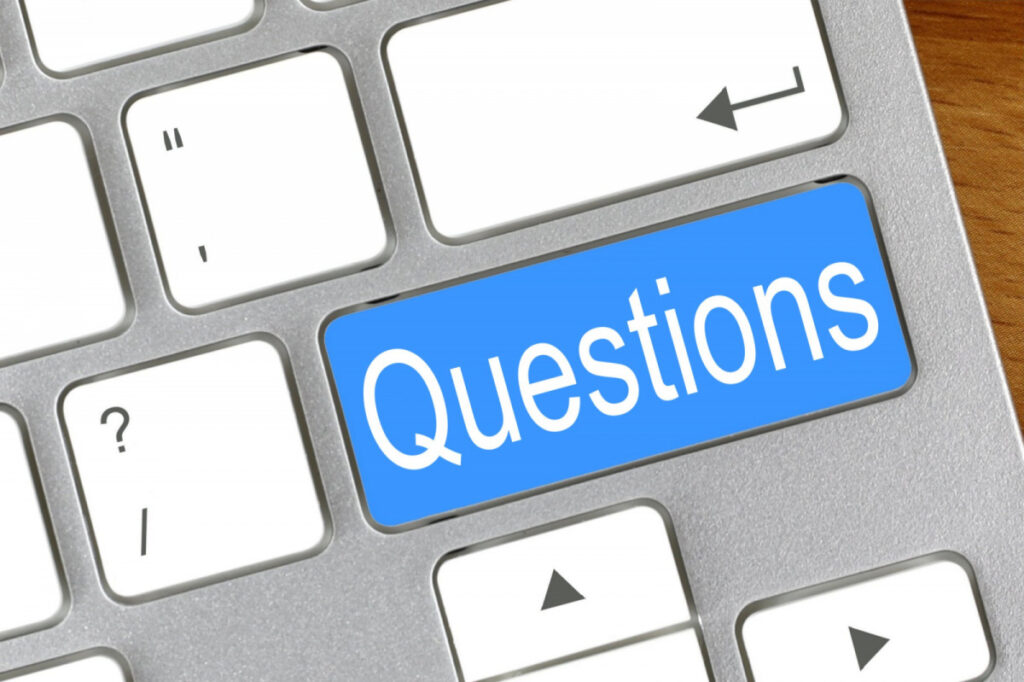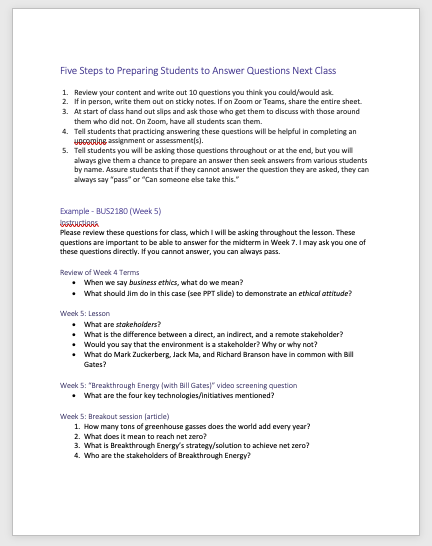When Students Don’t Answer Questions in Class
[Q]uestions are the breath of life for a conversation.
– James N. Miller

Questions in class should have a clear learning purpose, whether they aim to inspire or engage students, confirm their understanding, or deepen their learning. However, it can feel bewildering when the questions you ask are met with silence.
How do you respond when your students aren’t responding? Below, find reasons why students may not be answering your questions and ideas for adjusting your questioning strategy.
Students don’t understand the question
Your question may be too long or complex for students to fully understand what you are asking. Or, your question may include cultural knowledge (of a concept, place, person, or event) that your students don’t recognize. Or, your question may use jargon, colloquial language, or idiomatic English expressions that your students are unfamiliar with.
To form a question that students will understand,
- Write out your questions in advance, so when you deliver the questions they are simple, short, and to the point.
- Remove or adjust historically or culturally specific or historical references.
- Use plainspoken language, avoiding jargon, colloquialisms, or expressions in other languages (such carpe diem).
- Consider how you might re-phrase your question in simpler terms.
Students don’t have time to answer the question
One study of school-aged children (Jakwerth et al., 1999) found that students were most likely not to answer questions when they felt rushed through the content. Making silent time in class for thinking, processing, and writing can help students to see the value you place on answering questions in class.
To give your students time to answer your question,
- Write down the question on the board, in a slide, or in chat to see as well as hear the question, and state or repeat the question word for word.
- Count slowly to 15 or 20 to yourself after the question to give students time to formulate answers.
- Tell your class to think about an answer for 30-60 seconds but not to call out the answer. Keep track of the time, but maintain silence (including you). At the end of the thinking time, ask “Raise your hand if you’d like to share or if you have a thought or idea.”
- Give students time to write down the question during a lesson, and have them submit their answer on a piece of paper or by email to you after class.
A few students answer all the questions
Students may spend less cognitive effort in class by allowing a few vocal and confident classmates to answer all of your questions. This habit will be reinforced when you accept answers only from the same few students. As well, the more people who are in the classroom, the more likely students will assume another student will answer the question (a version of the “bystander effect”) (APA, n.d.).
To encourage wide-spread question answering and avoid the bystander effect,
- Keep track of who has already answered a question, and invite those students who have not yet answered a question to respond.
- “Thanks to everyone who has responded so far. Let’s hear from someone who has not yet shared.”
- “There are lots of ways to think about this topic. I’m interested in hearing from 3 different perspectives. Who has a different idea from the ones we have just heard?”
- Asks students to work together in groups to find the answer, such as a think-pair-share activity, before discussing as a large class.
- Ask students to write their answers and submit them (on paper, on a whiteboard, using chat), or use polling or survey software (Mentimeter, MS Forms, etc.)
- “I am not hearing from folks in this large class discussion format. So, let me ask this question another way using an anonymous poll.”
Students find the question too obvious
If the answer seems too obvious or leading (in which the answer is embedded in the question), students may think that it is a “trick question” or that the question needs no answer. For example, in a nutrition class, the question “Why do we want to include fruit in our diet” may seem too “easy” or self-evident to students.
To avoid asking “obvious” questions,
- State rather than question common knowledge or self-evident information, or explain why the answer to the question may not be so obvious
- “It may be already be widely accepted that fruit is important to include in our diet. What is the nutritional value that fruit contribute to our diets (that other foods may not)?”
- Ask open-ended questions that students will enjoy answering (and that you do not know the answer to)
- “I’m genuinely curious–what do you already know about X?”
- Ask “opposite thinking” questions or questions from a new vantage point or perspective
- “Let’s look at the topic of teamwork from the opposite perspective. What are some examples of ways to be a ‘bad’ team member?”
- Provide a way to gamify the questions to provide friendly competition (e.g., using a Jeopardy game)
- Take a poll first. E.g., ask first, “How many people watched a sporting event this weekend?” Then, ask students what they watched.
Students seem challenged to answer the question
If your students find the question is too difficult, they may need more contextual information, scaffolding, or explanation from you before they are ready to answer. This can include reviewing prior course work, explaining the criteria for a “good” answer, and giving model answers or prompts.
To provide structure and support for answering questions,
- Acknowledge when the question is difficult or the answer is not readily clear
- “This is a difficult question, so let’s try to explore some possible answers together as a group.”
- “This is a complex problem, so what is the first step that we can take to get to an answer?”
- Explain the kind of answer to your question you are looking for, and give specific instructions.
- Provide a model example or sentence starter prompt, such as a fill-in-the-blank:
- “Here is a reason why this is a good answer.”
- Activate prior knowledge or build on immediate observations to prompt thinking.
- “Remember last week when we talked about X?”
- “Looking at this problem, what do we already know?”
- Return to a closed question or a lower order thinking question to establish a common understanding.
- “Let’s go back and review the definition of this concept before we apply it to this case.”
- Build on answers that other students have provided previously, either to agree, disagree, or expand.
- “Let’s explore what X has already said about this. What else can we add?”
Students still seem reluctant to speak
Students may not feel psychologically safe answering the question you ask. They may be worried their responses will be dismissed or that they will be judged by you or by peers for giving the wrong answer. It is important to remember that your students may come from teacher-centred educational systems in which learners may not be encouraged to share personal opinions or answer complex questions in front of others. Be patient with students who need time to gain confidence with answering questions in class.
To encourage responses,
- Explain to students the purpose and goal of the question, relating it to the lesson outcomes.
- “The reason I am asking you this question is because a similar question may appear on the upcoming assignment, and with practice you may find the question easier to answer.”
- Ask questions that encourage students to talk about their accomplishments or unique experiences
- Give praise to students who make attempts to answer questions, even if their answers aren’t entirely correct
- Give a wrong answer to your own question, then ask students why they think the answer might be incorrect
- Use fictional problems and scenarios to talk about sensitive or difficult subjects, rather than rely on students sharing real-life information from their own lives
5 Steps to Preparing Students To Answer Questions Next Class
You can address many of the above issues by posting or providing your questions to students in advance of class. This strategy allows you to take time to form effective and answerable questions. It also gives students an opportunity to predict the content, get ready to listen for the questions, and respond to the question(s) they may receive.
See this downloadable handout, with an example, to help prepare students with your in-advance class questions.
Final thoughts: Listen to your students
Stay curious about what questions your students answer (or don’t answer). Strive to be an attentive listener, focusing as much on hearing and responding to answers as asking your questions. Whenever possible, weave your students’ answers give into the fabric your lessons; doing so shows students the high value you place on the “conversation” that questions and answers contribute to meaning-making in class.
For more information on forming effective questions, see Asking Effective Questions.
References
APA (n.d.). Bystander effect.
Boise State (2021). Engaging students in asking and answering questions.
Gonzalez, J. (2019). When you get nothing but crickets. Cult of Pedagogy.
Jackworth, P., Stancavage, F., Reed., E. (1991). An investigation of why students do not respond to questions. The NAEP Validity Studies (NVS) Panel.




